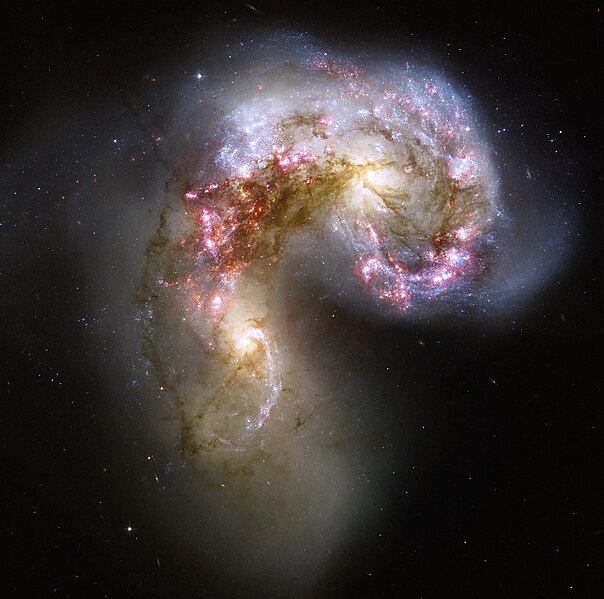Sary:Antennae galaxies xl.jpg

Haben'ny topi-maso: 604 × 599 teboka. Habe hafa: 242 × 240 teboka | 484 × 480 teboka | 774 × 768 teboka | 1 032 × 1 024 teboka | 2 064 × 2 048 teboka | 3 915 × 3 885 teboka
Rakitra niaviana (3 915 × 3 885 teboka, haben'ilay rakitra : 14,64 Mio, endrika MIME : image/jpeg)
Tantara ny rakitra
Tsindrio eo amin'ny daty/ora iray mba hijery ny toetra n'ilay rakitra tamin'io fotoana io.
| Daty sy ora | saritapaka | Habe | Mpikambana | resaka | |
|---|---|---|---|---|---|
| ankehitriny | 23 Aprily 2007 à 18:05 |  | 3 915 × 3 885 (14,64 Mio) | WilliamKF | == Description == This new NASA Hubble Space Telescope image of the Antennae galaxies (NGC 4038 & 4039) is the sharpest yet of this merging pair of galaxies. During the course of the collision, billions of stars will be formed. The brightest and most comp |
Fampiasana an'io rakitra io
Mampiasa ity rakitra ity ireo pejy 3 ireo:
Fampiasan-drakitra maneran-tontolo
Mampiasa ity rakitra ity ireo wiki hafa ireo:
- Fampiasana eo amin'i af.wikipedia.org
- Fampiasana eo amin'i ar.wikipedia.org
- مجرة
- بوابة:علم الفلك/تصنيفات
- مقراب هابل الفضائي
- تشكل وتطور المجرات
- مجرة انفجار نجمي
- فهرس المجرات وعناقيد المجرات
- فهرس كالدويل
- ويكيبيديا:صور مختارة/الفضاء والكون/نظرة إلى الأعلى
- بوابة:علم الفلك/صورة مختارة
- أطلس المجرات الغريبة
- بوابة:نجوم/مجرة
- ويكيبيديا:ترشيحات الصور المختارة/مجرتا الهوائيات
- ويكيبيديا:صورة اليوم المختارة/أبريل 2018
- قالب:صورة اليوم المختارة/2018-04-23
- بوابة:علم الفلك/صورة مختارة/60
- NGC 4038
- ويكيبيديا:صورة اليوم المختارة/أبريل 2020
- قالب:صورة اليوم المختارة/2020-04-23
- ويكيبيديا:صورة اليوم المختارة/مارس 2023
- قالب:صورة اليوم المختارة/2023-03-04
- Fampiasana eo amin'i ar.wiktionary.org
- Fampiasana eo amin'i arz.wikipedia.org
- مجره
- بوابة:علم الفلك/تصنيفات
- ESO 499 12 (مجره)
- VCCA 42 (مجره)
- LEDA 21644 (مجره)
- LEDA 83336 (مجره)
- LEDA 42596 (مجره)
- UGC 7485 (مجره)
- SDSSCGB 31599.1 (مجره)
- LEDA 2458152 (مجره)
- ESO 138 9 (مجره)
- NGC 3887 (مجره)
- ان جى سى 4697 (مجره)
- NGC 2549 (مجره)
- NGC 1249 (مجره)
- NGC 4517 (مجره)
- IC 3499 (مجره)
- IC 3446 (مجره)
- IC 1251 (مجره)
- IC 625 (مجره)
- NGC 3924 (مجره)
- UGC 1198 (مجره)
- NGC 4350 (مجره)
- NGC 4951 (مجره)
- ان جى سى 1515 (مجره)
Hijery fampiasana eran-terikasan'ity rakitra ity.



